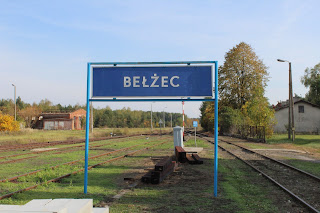The building of Operation Reinhard killing centres began in the Autumn of 1941. The locations of these killing centres was dictated by good rail connections and proximity to large populations of Jews These included Belzec, Sobibor and Treblinka II. In all three camps it is believed that carbon monoxide was pumped from stationary engines into gas chambers to kill the victims.
Belzec: In 1940, the Germans built a number of labour camps in the Belzec area to build the 'Otto Line', but were dismantled by October 1940. The construction of the extermination camp was completed at the end of February 1940. The entire camp occupied less than 73000m2 (275 x 265m). Fine boughs woven into the barbed-wire fence and trees planted around the perimeter served as camouflage to prevent curious outsiders from seeing operations inside the camp.
The camp was divided into two distinct sections (a combined administration-reception area and the killing area); Camp I which included the reception area and ramp (originally able to accommodate up to 15 train wagons, later a second ramp increased this to 40 wagons during the extermination phase), and two undressing barracks during the latter extermination phase, and Camp II which included the gas chambers and large rectangular burial pits. During the extermination phase two large barracks were built in Camp II as living quarters for the Jewish prisoners who worked there called Sonderkommander. The two camps were separated by a camourflaged fence with two gates. The gate near the end of the ramp lead through the forest to an execution pit. There was a passageway called "die Schleuse", ("the Sluice") (or 'Tube') connecting the undressing barracks in Camp I and the gas chambers in Camp II enclosed by camourflaged barbed-wire fences. Rail tracks ran from the gas chambers to the burial pits.
The killing operations at Belzec began in March 1942 and continued until December 1942.
 |
| Belzec train station |
 |
| Sobibor train station |
Sobibor extermination camp located on the outskirts of Sobibór near Lublin. The camp was run by the SS Sonderkommando Sobibor headed by Franz Stangl. The number of Jews from Poland and elsewhere who were gassed and cremated there between April 1942 and October 14, 1943 is estimated at 250,000.
The grounds of the camp were initially divided into three parts: camp I the SS-staff, camp II for the Jews who were put to work in the camp and camp III, isolated from the rest of the complex, housed a gas chamber, similarly to the one in Bełżec, for killing people by exhaust fumes produced by an engine. Initially, corpses were placed in mass graves in Camp III. In the late autumn of 1942, the bodies began to be incinerated on special grills made from rail tracks. There were also warehouses erected for the property plundered from the Jews.
In April 1942 Franz Stangl visited Belzec for a briefing by Wirth, the commander of Belzec extermination camp, concerning Stangl's duties as commandant at the soon to be opened Sobibor death camp. Sobibor began operating in May 1942 and remained functional until October 1943.
 |
| Original buffer at the end of the train track at Sobibor |
The camp consisted of two separate units. Treblinka I was a forced-labour camp (Arbeitslager) whose prisoners worked in the gravel pit or irrigation area and in the forest, where they cut wood to fuel the crematoria. Between 1941 and 1944, more than half of its 20,000 inmates died from summary executions, hunger, disease and mistreatment.
Treblinka II, was an extermination camp (Vernichtungslager). A small number of men who were not killed immediately upon arrival became its Jewish slave-labour units called Sonderkommandos, forced to bury the victims' bodies in mass graves. These bodies were exhumed in 1943 and cremated on large open-air pyres along with the bodies of new victims. Gassing operations at Treblinka II ended in October 1943 following a revolt by the Sonderkommandos in early August.
 |
| Teblinka map |


No comments:
Post a Comment